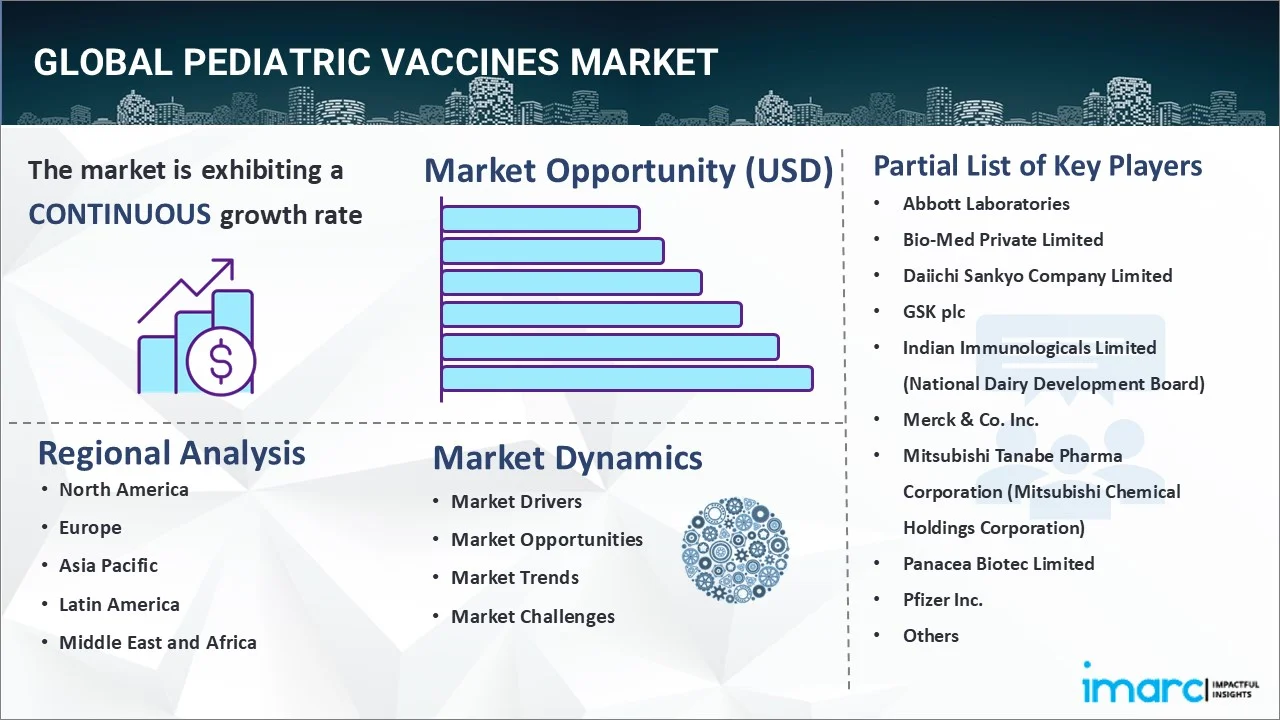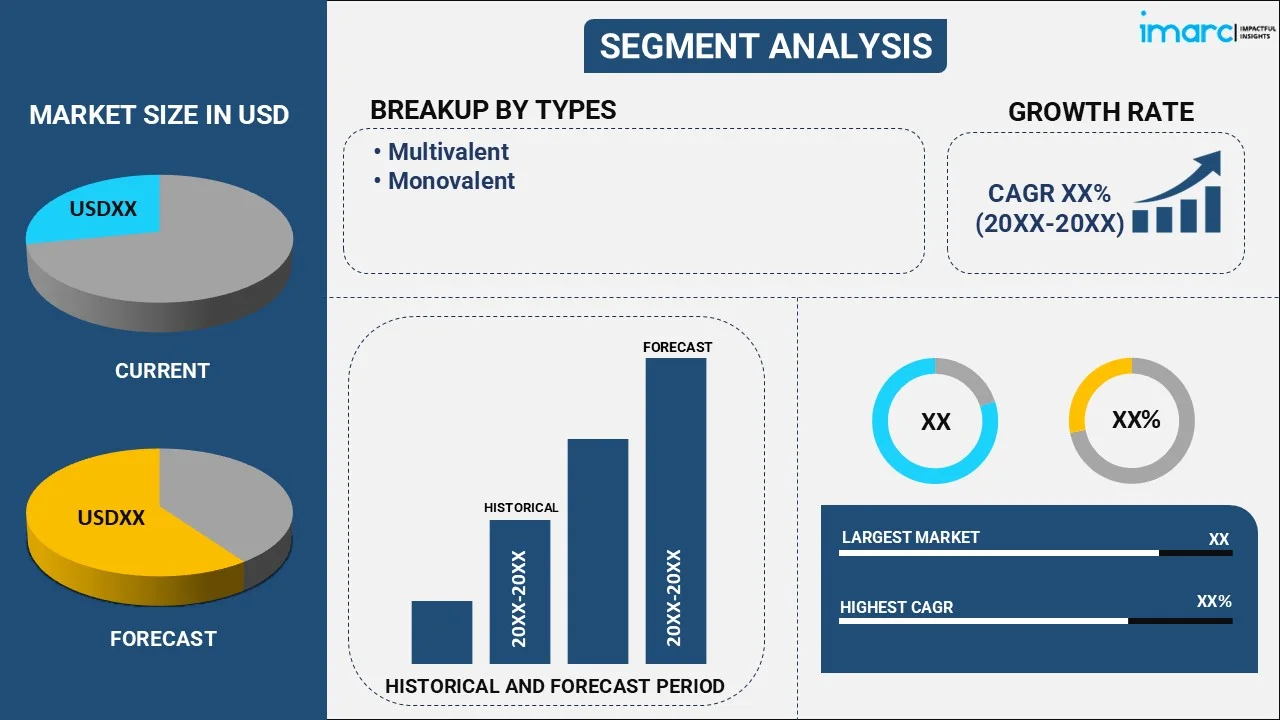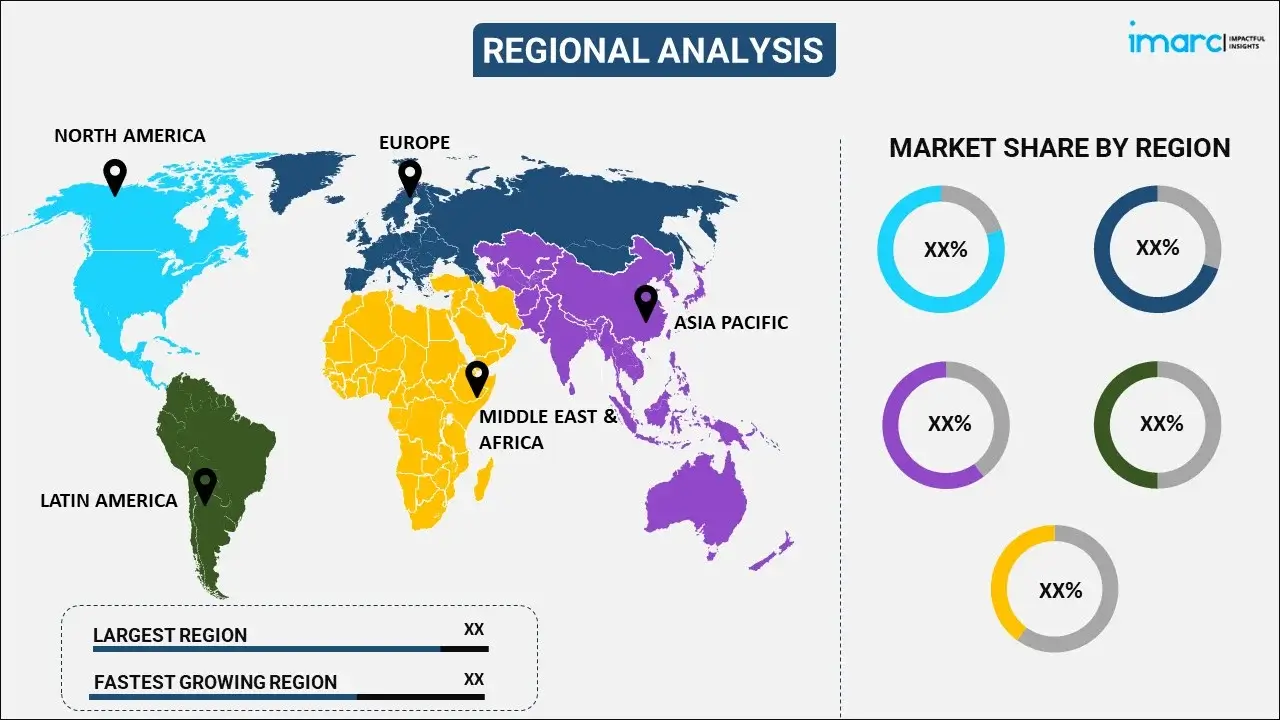
Pediatric Vaccines Market Report by Type (Multivalent, Monovalent), Technology (Conjugate, Live Attenuated, Inactivated, Subunit, Toxoid, and Others), Application (Infectious Disease, Cancer, Allergy, and Others), and Region 2025-2033
Market Overview:
The global pediatric vaccines market size reached USD 39.7 Billion in 2024. Looking forward, IMARC Group expects the market to reach USD 72.7 Billion by 2033, exhibiting a growth rate (CAGR) of 6.89% during 2025-2033. The growing conduction of vaccination programs, increasing focus on combination vaccines, and rising partnerships between pharmaceutical companies and healthcare organizations for fast-tracking the development and distribution of vaccines are some of the major factors propelling the market.
|
Report Attribute
|
Key Statistics
|
|---|---|
|
Base Year
|
2024 |
|
Forecast Years
|
2025-2033
|
|
Historical Years
|
2019-2024
|
| Market Size in 2024 | USD 39.7 Billion |
| Market Forecast in 2033 | USD 72.7 Billion |
| Market Growth Rate (2025-2033) |
6.89%
|
Pediatric vaccines are medical preparations that stimulate the immune system to recognize and fight specific infectious agents, such as bacteria or viruses. They comprise weakened or inactivated forms of the pathogens, or components of the pathogens, which prompt the immune system to develop a defense mechanism against the targeted disease. They provide protection from measles, polio, pertussis (whooping cough), hepatitis, and influenza. They undergo rigorous testing and evaluation to ensure their safety before being approved for use. They prevent the spread of diseases that can cause severe complications or death in children.

At present, the increasing occurrence of various infectious and potentially life-threatening diseases, such as polio, tuberculosis (TB), and malaria among children, is impelling the growth of the market. Besides this, rising government initiatives around the world aimed at immunizing children against preventable diseases are contributing to the growth of the market. In addition, the growing technological advancements in vaccine storage and distribution methods for improving the supply chain in regions where medical infrastructure may be less developed are offering a favorable market outlook. Apart from this, increasing partnerships between pharmaceutical companies and healthcare organizations for fast-tracking the development and distribution of vaccines are supporting the growth of the market. Additionally, the rising construction of clinics and hospitals around the world to improve healthcare services is bolstering the growth of the market.
Pediatric Vaccines Market Trends/Drivers:
Growing conduction of vaccination programs
The increasing implementation of vaccination programs is notably bolstering the pediatric vaccines market. These vaccination initiatives, supported by governmental and non-governmental organizations, play a pivotal role in safeguarding the health and well-being of children. As more children receive essential immunizations against various diseases, the demand for pediatric vaccines experiences a proportional rise. Besides this, vaccination programs, with their focus on disease prevention, are decreasing the incidence of targeted illnesses among children. This subsequently translates into a reduced burden on healthcare systems and families, thereby enhancing the overall quality of life for children and their caregivers. Furthermore, the growing awareness among parents and healthcare providers about the importance of immunizations is rising the vaccine uptake rates.
Increasing focus on combination vaccines
The heightened emphasis on combination vaccines is contributing to the positive evolution of the pediatric vaccines market. Combination vaccines offer a strategic approach to immunization by providing protection against multiple diseases in a single formulation. This approach simplifies the vaccination process for healthcare providers, caregivers, and children alike, resulting in improved compliance and vaccine coverage rates. Moreover, combination vaccines address the challenges of vaccine hesitancy and the possibility of missed doses. As children receive protection against multiple diseases with one injection, the perceived burden of vaccinations is significantly reduced. This encourages parents to adhere to recommended vaccination schedules and contributes to achieving higher rates of full immunization coverage.
Rising development of novel vaccines
The increasing development of novel vaccines is playing a pivotal role in driving positive growth within the pediatric vaccines market. The emergence of new vaccines tailored specifically for the health needs of children contributes to enhanced disease prevention, improved public health outcomes, and expanded market opportunities. The development of novel vaccines also reflects advancements in vaccine technology and research. Cutting-edge research methodologies, such as genomics and bioinformatics, enable scientists to identify potential vaccine candidates more rapidly and accurately. This accelerated pace of discovery is creating vaccines that are efficacious and align with the evolving epidemiological landscape. Furthermore, the rising development of novel vaccines is stimulating collaboration between public health organizations, research institutions, and vaccine manufacturers. These partnerships facilitate the timely introduction of new vaccines and ensure their efficient distribution to the pediatric population.
Pediatric Vaccines Industry Segmentation:
IMARC Group provides an analysis of the key trends in each segment of the global pediatric vaccines market report, along with forecasts at the global, regional, and country levels for 2025-2033. Our report has categorized the market based on type, technology, and application.
Breakup by Type:

- Multivalent
- Monovalent
Multivalent dominates the market
The report has provided a detailed breakup and analysis of the market based on the type. This includes multivalent and monovalent. According to the report, multivalent represented the largest segment.
Multivalent pediatric vaccines refer to immunization formulations that provide protection against multiple diseases through a single vaccine injection. These vaccines are designed to target two or more different disease-causing agents, such as viruses or bacteria, in a single formulation. Multivalent pediatric vaccines streamline the vaccination process by offering protection against multiple diseases with a single injection. This eliminates the need for multiple shots, reducing discomfort for children and simplifying the vaccination schedule for healthcare providers and caregivers. Multivalent pediatric vaccines optimize healthcare resources by combining multiple vaccines into a single formulation. This can result in cost savings for healthcare systems and reduce the logistical challenges associated with administering separate vaccines.
Breakup by Technology:
- Conjugate
- Live Attenuated
- Inactivated
- Subunit
- Toxoid
- Others
Conjugate holds the largest share in the market
A detailed breakup and analysis of the market based on the technology has also been provided in the report. This includes conjugate, live attenuated, inactivated, subunit, toxoid, and others. According to the report, conjugate accounted for the largest market share.
Conjugate vaccines are a type of immunization that enhances the immune response against certain bacteria that have a protective polysaccharide outer coating. These vaccines work by linking or conjugating the bacterial polysaccharides to a carrier protein, creating a complex that stimulates a stronger and more effective immune response, especially in young children whose immune systems might not respond well to polysaccharides alone. Conjugate vaccines not only protect vaccinated individuals but can also reduce the carriage of bacteria in the population. This indirectly limits the spread of bacteria among both vaccinated and unvaccinated individuals. Conjugate vaccines contribute to herd immunity, which is essential for the prevention of the spreading of various infectious diseases among unvaccinated individuals.
Breakup by Application:
- Infectious Disease
- Cancer
- Allergy
- Others
A detailed breakup and analysis of the market based on the application have also been provided in the report. This includes infectious disease, cancer, allergy, and others.
Pediatric vaccines play a crucial role in preventing infectious diseases among children. By providing immunity against harmful pathogens, vaccines contribute to the health and well-being of children and infants. These vaccines are carefully developed based on scientific examination and clinical trials to ensure their safety and effectiveness.
Pediatric vaccines for cancer aim to prevent certain types of cancers that primarily affect children. They target certain infections, such as human papillomavirus (HPV) and hepatitis B virus (HBV) and are known to increase the risk of developing cancer. Besides this, administering vaccines during childhood allows for early prevention of cancer-related infections. This early intervention aligns with a proactive health approach, reducing the risk of cancer development later in life.
Pediatric vaccines play a crucial role in preventing a range of allergies among children. By bolstering the response of the immune system, vaccines help mitigate the risk of developing allergies to common allergens like pollen, dust, and pet dander.
Breakup by Region:

- North America
- United States
- Canada
- Asia-Pacific
- China
- Japan
- India
- South Korea
- Australia
- Indonesia
- Others
- Europe
- Germany
- France
- United Kingdom
- Italy
- Spain
- Russia
- Others
- Latin America
- Brazil
- Mexico
- Others
- Middle East and Africa
North America exhibits a clear dominance, accounting for the largest pediatric vaccines market share
The market research report has also provided a comprehensive analysis of all the major regional markets, which include North America (the United States and Canada); Asia Pacific (China, Japan, India, South Korea, Australia, Indonesia, and others); Europe (Germany, France, the United Kingdom, Italy, Spain, Russia, and others); Latin America (Brazil, Mexico, and others); and the Middle East and Africa. According to the report, North America accounted for the largest market share.
North America held the biggest market share since the region due to the rising investment in research operations for the development of various novel vaccines for the prevention of infectious and chronic diseases. Besides this, the increasing awareness among parents and caregivers about the importance of immunization is propelling the growth of the market. Apart from this, rising improvements in the healthcare infrastructure to provide quality treatment and other healthcare facilities to individuals are supporting the growth of the market.
Asia Pacific is estimated to expand further in this domain due to the increasing occurrence of infectious diseases caused by various novel viruses. Besides this, rising initiatives taken by governing agencies and regulatory bodies to promote the significance of vaccination in children are bolstering the growth of the market.
Competitive Landscape:
Key market players are diligently focused on enhancing their business strategies by consistently investing in research operations to formulate innovative vaccines that cater to evolving healthcare needs. They are fostering collaborations with research institutions and regulatory bodies to ensure the safety and efficacy of their products. Leading companies are strengthening their supply chain management and distribution networks to ensure timely availability of vaccines. Furthermore, top industry players are actively engaging in educational initiatives to increase awareness about the importance of vaccination, fostering trust and credibility within the community. This concerted effort to innovate, collaborate, and educate showcases their commitment to advancing the field of pediatric vaccines and contributing to public health on a global scale.
The report has provided a comprehensive analysis of the competitive landscape in the market. Detailed profiles of all major companies have also been provided. Some of the key players in the market include:
- Abbott Laboratories
- Bio-Med Private Limited
- Daiichi Sankyo Company Limited
- GSK plc
- Indian Immunologicals Limited (National Dairy Development Board)
- Merck & Co. Inc.
- Mitsubishi Tanabe Pharma Corporation (Mitsubishi Chemical Holdings Corporation)
- Panacea Biotec Limited
- Pfizer Inc.
- Sanofi S.A.
- Sinovac Biotech Ltd.
Pediatric Vaccines Market Report Scope:
| Report Features | Details |
|---|---|
| Base Year of the Analysis | 2024 |
| Historical Period | 2019-2024 |
| Forecast Period | 2025-2033 |
| Units | Billion USD |
| Scope of the Report | Exploration of Historical Trends and Market Outlook, Industry Catalysts and Challenges, Segment-Wise Historical and Predictive Market Assessment:
|
| Types Covered | Multivalent, Monovalent |
| Technologies Covered | Conjugate, Live Attenuated, Inactivated, Subunit, Toxoid, Others |
| Applications covered | Infectious Disease, Cancer, Allergy, Others |
| Regions Covered | Asia Pacific, Europe, North America, Latin America, Middle East and Africa |
| Countries Covered | United States, Canada, Germany, France, United Kingdom, Italy, Spain, Russia, China, Japan, India, South Korea, Australia, Indonesia, Brazil, Mexico |
| Companies Covered | Abbott Laboratories, Bio-Med Private Limited, Daiichi Sankyo Company Limited, GSK plc, Indian Immunologicals Limited (National Dairy Development Board), Merck & Co. Inc., Mitsubishi Tanabe Pharma Corporation (Mitsubishi Chemical Holdings Corporation), Panacea Biotec Limited, Pfizer Inc., Sanofi S.A., Sinovac Biotech Ltd., etc. |
| Customization Scope | 10% Free Customization |
| Post-Sale Analyst Support | 10-12 Weeks |
| Delivery Format | PDF and Excel through Email (We can also provide the editable version of the report in PPT/Word format on special request) |
Key Benefits for Stakeholders:
- IMARC’s industry report offers a comprehensive quantitative analysis of various market segments, historical and current market trends, market forecasts, and dynamics of the pediatric vaccines market from 2019-2033.
- The research report provides the latest information on the market drivers, challenges, and opportunities in the global pediatric vaccines market.
- The study maps the leading, as well as the fastest-growing, regional markets. It further enables stakeholders to identify the key country-level markets within each region.
- Porter's five forces analysis assist stakeholders in assessing the impact of new entrants, competitive rivalry, supplier power, buyer power, and the threat of substitution. It helps stakeholders to analyze the level of competition within the pediatric vaccines industry and its attractiveness.
- Competitive landscape allows stakeholders to understand their competitive environment and provides an insight into the current positions of key players in the market.
Key Questions Answered in This Report
The global pediatric vaccines market was valued at USD 39.7 Billion in 2024.
We expect the global pediatric vaccines market to exhibit a CAGR of 6.89% during 2025-2033.
The rising prevalence of various pediatric diseases, along with the introduction of new pediatric vaccines that aid for treating adolescents and children with Relapsing forms of Multiple Sclerosis (RMS), is primarily driving the global pediatric vaccines market.
The sudden outbreak of the COVID-19 pandemic had led to the growing focus on the development and supply chain of the coronavirus infection, thereby negatively impacting the global market for pediatric vaccines.
Based on the type, the global pediatric vaccines market has been segmented into multivalent and monovalent. Currently, multivalent holds the majority of the total market share.
Based on the technology, the global pediatric vaccines market can be divided into conjugate, live attenuated, inactivated, subunit, toxoid, and others. Among these, conjugate exhibits a clear dominance in the market.
On a regional level, the market has been classified into North America, Asia-Pacific, Europe, Latin America, and Middle East and Africa, where North America currently dominates the global market.
Some of the major players in the global pediatric vaccines market include Abbott Laboratories, Bio-Med Private Limited, Daiichi Sankyo Company Limited, GSK plc, Indian Immunologicals Limited (National Dairy Development Board), Merck & Co. Inc., Mitsubishi Tanabe Pharma Corporation (Mitsubishi Chemical Holdings Corporation), Panacea Biotec Limited, Pfizer Inc., Sanofi S.A., and Sinovac Biotech Ltd.
Need more help?
- Speak to our experienced analysts for insights on the current market scenarios.
- Include additional segments and countries to customize the report as per your requirement.
- Gain an unparalleled competitive advantage in your domain by understanding how to utilize the report and positively impacting your operations and revenue.
- For further assistance, please connect with our analysts.
 Inquire Before Buying
Inquire Before Buying
 Speak to an Analyst
Speak to an Analyst
 Request Brochure
Request Brochure
 Request Customization
Request Customization




.webp)




.webp)












